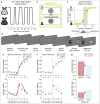Efficient stabilization of imprecise statistical inference through conditional belief updating
- PMID: 36138224
- PMCID: PMC7617215
- DOI: 10.1038/s41562-022-01445-0
Efficient stabilization of imprecise statistical inference through conditional belief updating
Abstract
Statistical inference is the optimal process for forming and maintaining accurate beliefs about uncertain environments. However, human inference comes with costs due to its associated biases and limited precision. Indeed, biased or imprecise inference can trigger variable beliefs and unwarranted changes in behaviour. Here, by studying decisions in a sequential categorization task based on noisy visual stimuli, we obtained converging evidence that humans reduce the variability of their beliefs by updating them only when the reliability of incoming sensory information is judged as sufficiently strong. Instead of integrating the evidence provided by all stimuli, participants actively discarded as much as a third of stimuli. This conditional belief updating strategy shows good test-retest reliability, correlates with perceptual confidence and explains human behaviour better than previously described strategies. This seemingly suboptimal strategy not only reduces the costs of imprecise computations but also, counterintuitively, increases the accuracy of resulting decisions.
© 2022. The Author(s), under exclusive licence to Springer Nature Limited.
Conflict of interest statement
The authors declare no competing interests.
Figures








References
-
- Wald A, Wolfowitz J. Optimum character of the sequential probability ratio test. Ann Math Stat. 1948;19:326–339.
-
- Bogacz R, Brown E, Moehlis J, Holmes P, Cohen JD. The physics of optimal decision making: a formal analysis of models of performance in two-alternative forced-choice tasks. Psychol Rev. 2006;113:700–765. - PubMed
-
- Green DM, Swets JA. Signal detection theory and psychophysics. xi. John Wiley; 1966. p. 455.
-
- Drugowitsch J, Wyart V, Devauchelle A-D, Koechlin E. Computational precision of mental inference as critical source of human choice suboptimality. Neuron. 2016;92:1398–1411. - PubMed
-
- Wyart V, Koechlin E. Choice variability and suboptimality in uncertain environments. Curr Opin Behav Sci. 2016;11:109–115.
Publication types
MeSH terms
Grants and funding
LinkOut - more resources
Full Text Sources

